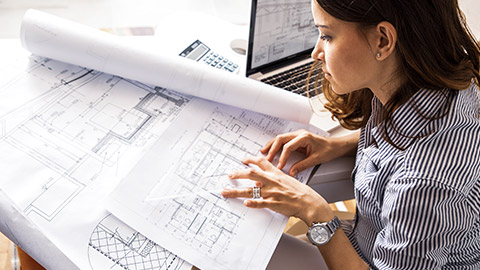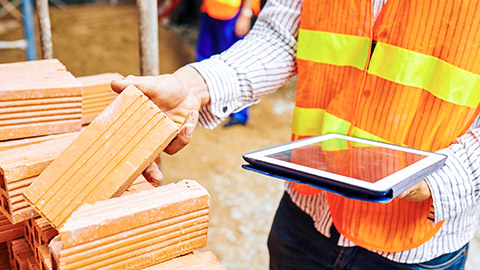Regardless of the task or project that you will be undertaking, there are some common things you will need to do each time that you begin the planning and organising stage. While not every task will require all of these steps, the majority of tasks will require most of them.
Step 1: Review documents
- Work instructions
- Plans and specifications.
- Drawings
- Work orders
- Safe Work Method Statements (SWMS)
- Job Safety and Environmental Analysis (JSEA)
NOTE: Ensure that you have the most recent versions.
Step 2: Review the legislation
- Laws and regulations
- National Construction Code (NCC)
- Australian Standards
- Environmental requirements
- Work health and safety requirements.
Step 3: Consider safety
- Safe Work Method Statements (SWMS)
- Personal Protective Equipment (PPE)
- Job Safety and Environmental Analysis (JSEA)
- Manufacturer specifications and instructions.
- Inspect the worksite to assess hazards (including environmental and safety) and implement risk control
Step 4: Break the project down into its component tasks
- What do you need to do for each component?
- What tools and equipment do you need at each stage?
- What other resources do you need?
- How many people will you need for each stage?
- How long will each stage take?
Step 5: Plan the sequence of tasks
- Ensure that the flow is logical and efficient
- Ensure that the workflow maximises safety
- Maximise the efficient use of resources.
Step 6: Document the plan
- Prepare a written work plan
- Prepare a resources list.

The first step in planning for any building or construction task is to look carefully at your work instructions or work order and the plans and specifications. These documents are the road map for the project. So, what are these documents, and what do they tell you?
Work instructions
Work instructions (sometimes called work orders) are documents that outline the requirements of the job or project. They will usually describe the project and specify the timeline. They may also:
- state the budget
- list the relevant workplace policies and procedures
- list members of the project team and their contact details
- reference the plans and specs
- include other information relevant to the job.
On some projects, the work instructions will be provided to you verbally by your instructor or site supervisor, and you actively listen, and it is recommended you take notes.
Plans and specifications
Plans are the technical drawings (sometimes called a graphical representation) of the job. They include technical language, measurements, abbreviations, symbols, marks and other information for the different parties involved in a project. Specifications are the written details of the job. Several other documents support the plans and specifications.
Plans/drawings
Plans or drawings provide a graphical representation of:
- what the finished product will look like
- what the owner or client wants
- rooms, bathrooms
- plumbing and electrical and where they run through the building
- air conditioning vents
- outdoors.
Specifications
The specifications go hand in hand with the drawings. As the name indicates, the specifications are the details about the drawings. For example, when a house is ready to have a slab poured, the specifications would outline the slab's exact measurements, including the size and depth. This is the foundation of the build and very important. If the slab specifications are not accurate, the slab will not be poured accurately, resulting in several faults with any progressing construction that will occur. The specifications are also bound legally, as they too need to meet industry standards and need approval from the relevant authority to ensure they have been developed properly.
The following list outlines some of the details that specifications provide:
- A description of the quality that the project must be built.
- A description of the Standards that the project must meet.
- A description of the materials that will be used.
- Consistency – if the project is to be completed more than once, it will be done the same way each time.
- Measurements and dimensions of the build (if a house, it would include measurements of each room and area).
- Positioning of the framework, piers.
- Height measurements do not exceed building legislation.
- Where the electrical is required.
- Where plumbing is required.
- Waterproofing heights in the walls, how to waterproof the first floor and second floor, requirements for a balcony, minimum waterproofing heights, types of waterproofing, etc.
Fun fact!
Did you know? Drawings and specifications are also legally bound records that need to be approved by various parties to ensure they follow the Australian Builder’s Associations.
Supporting documents
The plans and specifications do not stand alone; many other important details need to be factored in, especially considering these are legally bound. Several documents support the plans the specifications. Each provides additional information. Not all projects will have every one of these documents. Supporting documents are outlined as follows.
Location plan
If you are working on a building, the location plan will show the block of land where the build is to take place and surrounding blocks of land on the street.
Site plan
If you are working on a building, the site plan shows the location of the building on the property.
Sections
The sections are slices or crosscuts of a building. They show things like frame and roof construction as well as the foundation and timber specifications.
Elevations
Elevations show the vertical dimensions of a building from four sides.
Floor plan
The floor plan shows the interior layout of a building.
Electrical plan
The electrical plan shows where all of the electrical elements in a building will be positioned.
Window and door schedules
Window and door schedules provide information about all of the windows and doors required for a building.
Environmental management plans
The environmental management plans provide information about sustainability, waste management and other environmental issues such as dust control, stormwater management, management of noise and vibration and so on.
Safe work method statements
A safe work method statement (SWMS) is a planning tool that identifies the hazards and risks associated with those activities that are high risk and documents the controls that will be put in place to control the risks and ensure that the work will be done safely.
Job safety and environmental analysis
Job safety and environmental analysis (JSEA) is a planning tool that analyses high-risk work activities and documents the controls that will be put in place in the same way that an SWMS does. Still, it also incorporates environmental as well as health and safety issues.
Work orders
A work order is an official document giving you authority to proceed with the work.
Work instructions
Work instructions are instructions that you receive from your supervisor. They may be written or verbal.
Workplace policies and procedures
Your workplace’s policies and procedures will guide safety, quality and a range of other processes.
Manufacturer specifications
Manufacturer instructions and specifications outline how to use, maintain and store tools and equipment safely and effectively.
Safety data sheets
Safety data sheets (SDSs) are documents that provide safety and environmental information about hazardous chemicals.
Information from the plans and specs
At this stage, you should review the documents by using the following checklist, or one similar.
| No. | Check the following: | Complete? |
|---|---|---|
| 1 | You have all the information that you need | Y / N |
| 2 | you have the most recent copies of the documents | Y / N |
| 3 | You understand what it is that you need to do – if you are uncertain, ask questions immediately, don’t wait | Y / N |
| 4 | The tools and equipment that you will need | Y / N |
| 5 | Safety hazards and risk controls | Y / N |
| 6 | Materials you will need | Y / N |
| 7 | Other resources you will need | Y / N |
| 8 | The legislation, policies and procedures, manufacturer instructions, SDSs, Standards and Codes of Practice you will need to adhere to | Y / N |
| 9 | The PPE you will need | Y / N |
You should also have enough information at this stage to break the project down into its component tasks.
Remember, when you are in the initial stages of planning the project you will need to include the following 7 requirements, or types of information.
- Regulations.
- Standards.
- Drawings and specifications.
- Timelines.
- Resources including relevant personnel.
- Tools and equipment including PPE.
- Safety and environmental considerations.

The building and construction industry is highly regulated. This is in order to keep workers safe and ensure that buildings are constructed with an emphasis on quality in design and construction, health and safety and sustainability. It also helps to protect consumers, help resolve disputes and secure payments.
The next step in planning and preparing is to review the legislation, standards and codes to ensure that the work that you do is compliant. Your work must be compliant with:
- Federal, state and local government laws
- National Construction Codes
- Australian Standards
- Work health and safety requirements (including SWMS and model code of practice requirements)
- Environmental requirements.
On their website, Standards Australia describes Australian Standards as:
‘…voluntary documents that set out specifications, procedures and guidelines that aim to ensure products, services, and systems are safe, consistent, and reliable.
They cover a variety of subjects, including consumer products and services, the environment, construction, energy and water utilities, and more.’2
You will find a lot of the information that you need to help you identify relevant legislation in the plans, specs and supporting documents. For example:
- you will find Australian Standard and NCC requirements on plans and specs
- you will find WHS requirements in an SWMS or JSEA
- you will find environmental requirements in an environmental management plan
- following your workplace policies and procedures will help you to ensure that you are fulfilling your legislative requirements
- manufacturer specifications usually include safety information and often include SDS and/or Australian Standards information.
If you would like to know more about the regulatory framework in your state or territory, follow the relevant link below.
One of the most important reasons for comprehensive planning and organising is to ensure the safety of the project and everyone involved. You will learn about workplace health and safety in more detail throughout your study. For now, let’s look at the importance of identifying hazards, risks and controls during the planning and organising phase.
Hazards, risks and controls
Hazards
A hazard is something that is identified as having the potential to harm any of the people on site. Remember that harm can mean a physical injury, an illness including a psychological illness or even death.
Risk
Risk refers to the likelihood that the hazard will occur and what the significance of the harm will be.
Control
Controls are the strategies put in place to mitigate (prevent and/or manage) the hazards and risks.
Information about hazards, risks and controls can come from:
- plans and specs
- SWMS
- JSEAs
- workplace policies and procedures
- SDSs
- manufacturer instructions and specifications
- Model Codes of Practice for high-risk activities.
Now that you have developed your understanding of hazards, we will now look at what you can do in order to protect yourself while you are on a jobsite. Many of you may already be familiar with Personal Protective Equipment (PPE). However, there are in fact other details that you also need to consider when establishing your understanding of the importance of this equipment and why it must be present on every jobsite you walk on.
What is Personal Protective Equipment?
Personal protective equipment or PPE is essential and specific to various industries. In construction, it is a mandatory legislative requirement that you have access to quality PPE specific to the construction industry. Whenever you are on-site, it will be expected that you are equipped with all of the relevant PPE to ensure your own safety and the safety of others. It is however important to consider, PPE is not a solution to the hazard, it is there to protect you.
Take some time to scroll through the images below to view some of the common tools, equipment and PPE items you’ll likely encounter.

